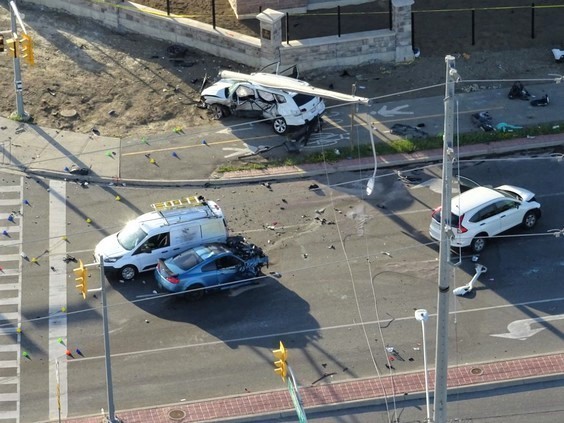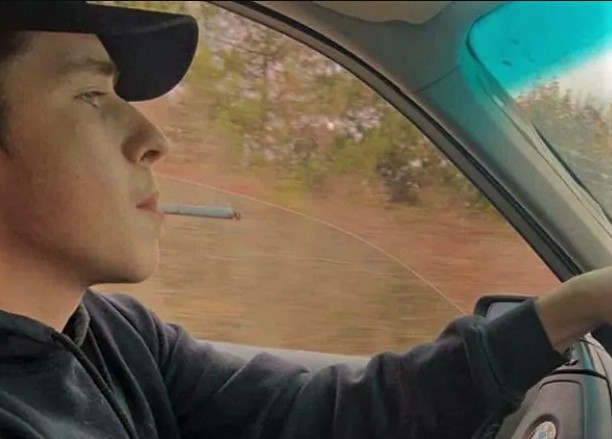
Judgement withheld on Brady Robertson’s sobriety during deadly crash as constitutional challenge around driving laws & cannabis use continues
In a historical case for imparied driving, Justice Sandra Caponecchia is being cautious in deciding whether 21-year-old Brady Robertson was impaired by the drugs in his system when he crashed his speeding car into the SUV driven by a Caledon mother who was killed along with her three young daughters.
In a Voir Dire decision handed down by the judge on November 2, she did not offer a final ruling on the defence’s arguments relating to the effects of chemicals in Robertson’s blood samples and whether or not they caused impairment while driving. She reserved a final decision until a constitutional challenge by the defence on the evidence is decided, but did find certain evidence used by the Crown has not met the threshold of “beyond a reasonable doubt”.
She did rule on a separate matter, and decided Robertson was indeed the driver in an incident two days before the fatal crash which resulted in a dangerous driving charge.
A Voir Dire is a special hearing process within a trial to rule on the admissibility of evidence used in the broader case.
Robertson’s lawyers are challenging the constitutionality of Canada’s impaired driving laws, claiming they are too broad and arbitrary when it comes to THC, the active ingredient of cannabis.
In early November, the judge ruled the Crown Attorney Patrick Quilty had not proven beyond a reasonable doubt that Robertson was impaired by drugs at the time of the accident, despite understanding he had narcotics in his system. She is saving judgment on the four impaired driving charges Robertson pled not-guilty to until the conclusion of a constitutional challenge against Canada’s impaired driving law, put forward by Robertson’s defence, led by Craig Bottomley and Mayleah Quenneville. Robertson previously pleaded guilty to dangerous driving charges.
The current legal limit is 5 nanograms per millilitre of blood, Robertson’s blood, according to a sample taken shortly after the accident, had eight times that amount.
In the aftermath of the brutally reckless behaviour by Robertson on June 18, 2020, when he plowed his vehicle into the SUV at the intersection of Torbram Road and Countryside Drive in Brampton, Robertson, 20 at the time, was taken to hospital with non-life threatening injuries.
He was driving a blue Infiniti G35 allegedly at about 167 kilometres per hour as he approached the intersection (according to police evidence, but the judge has accepted some defence evidence refuting this estimated speed), swerved out of control around a vehicle into the left hand turning lane before turning wildly back toward cars waiting at the lights, striking the SUV with Karolina Ciasullo and her daughters inside which then crashed forward into a large concrete light standard that fell directly on the middle of the entire length of the vehicle, crushing it further. The girls were all under the age of 6.

Brady Robertson had drugs in his system at the time of the crash that killed a Caledon family. Whether the amount was enough to cause impairment is still to be decided.
(Photo from Facebook)
At the beginning of the case, Robertson pleaded guilty to four counts of dangerous operation of a motor vehicle causing death, and not guilty to four counts of impaired driving and a dangerous driving charge involving another reckless incident caught on video two days before the deadly collision.
The accident happened at approximately 12:15 p.m., and shortly after, Robertson was rushed to Brampton Civic Hospital where staff drew blood at 1 p.m. This sample showed there was approximately 21 nanograms per millilitre of flubromazolam, a sedative known as liquid xanax. The exact quantity of the drug was not measured by hospital staff.
Robertson’s blood also showed approximately 40 nanograms per millilitre of THC at 1 p.m.
By 3:21 p.m., after Robertson was transferred, staff at St. Michael’s Hospital in Toronto took a second blood sample. It showed between .625 nanograms and 1.3 nanograms per millilitre of fentanyl in his system, which Judge Caponecchia believes was administered to Robertson by hospital staff for the pain, which is why the blood drawn at 1 p.m. tested negative for the drug.
The second sample also showed an unknown amount of flubromazolam detected along with about 15 nanograms per millilitre of THC.
The judge is certain the psychoactive ingredient, which can act as a hallucinogen, was not administered by paramedics or hospital staff as it is not used as a legal drug. She also is certain Robertson had drugs in his blood at the time of the accident, based on the blood samples entered as evidence.
In a previous court hearing for the case, forensic toxicologist Betty Chow testified and explained the science behind the blood samples. She said there was no reliable scientific method to determine how much flubromazolam was in Robertson’s blood at the time of the accident based on blood drawn 45 minutes later. The drug can be detected days after being administered and could have been taken up to 40 hours before Robertson killed the young family.
“I am satisfied that the evidence establishes that the drug was in Mr. Robertson’s blood because he consumed an unknown quantity on or before the collision on June 18, 2020 and it was still in his blood at the time of the crash,” Judge Caponecchia wrote in her ruling November 2.
Chow explained the decrease of THC in the blood as of the second sample suggested a recent consumption of cannabis, she defined this as between four to six hours prior to 1 p.m. With this knowledge the judge believes Robertson consumed an unknown quantity of cannabis in the morning, before he smashed his vehicle into the SUV, killing a mother and her three young daughters. Chow said it would be difficult to determine what Robertson’s exact THC levels would have been when he was driving. The first blood sample shows he had eight times the legal limit about 45 minutes after the crash.
Was Robertson’s ability to operate a motor vehicle impaired by drugs?
This was the question Judge Caponecchia had to ask herself after seeing evidence from both sides. Relying heavily on Chow’s “balanced and fair” testimony, the judge laid out her reasoning for why she believes the Crown did not prove beyond a reasonable doubt Robertson was impaired.
Chow described the impairing effects of flubromazolam and THC on people generally, explaining how certain ways of consuming the drugs and the timing of consumption play a role in how affected someone is.
Flubromazolam impairs the ability to drive because it affects the central nervous system; the higher the dose the greater the effect. When ingested an individual can feel the effects between 30 minutes to an hour later, if taken through a blotter where the drug is placed on a specific paper then eaten (absorption) the effects are quicker and can last 8 to 10 hours depending on the dose.
Chow said the first sample of blood showing the ingredient is consistent with recreational use, and has an unknown time of consumption, due to the nature of the drug. Chow said she would need more information on when Robertson took it and his tolerance for the drug to better understand how it affected him at the time of the accident.
THC has impairing effects, can increase heart rate, blood pressure and impact attention, motor skills along with someone’s perception of time. The effects of THC set in within minutes of smoking cannabis but are delayed up to a half an hour if consumed as an edible. If consumed as an edible, effects can last up to eight hours, whereas when smoking the substance, the impairing effects will be most present one to two hours afterward and can persist four to six hours.
In Robertson’s case, Chow explained the 40 nanograms per millilitre of THC detected at 1:00 p.m. is not enough information to determine whether he was imparied to any degree at the time of the accident. Depending on the timing, quantity, consumption method and his tolerance level, Robertson may or may not have been impaired by the effects of THC, according to Chow.
“It does not go so far as to prove the drugs were necessarily impairing Mr. Robertson's ability to drive,” Judge Caponecchia wrote. “It is my overall assessment that Mr. Robertson's ability to operate a motor vehicle was probably and most likely impaired by drug on June 18, 2020. Yet such a conclusion is not proof beyond a reasonable doubt.”
Two days prior to the accident, on June 16, the same blue Infiniti G35 was seen driving recklessly in a nearby area. Three civilian witnesses and a police officer testified the vehicle was involved in two incidents six kilometres apart.
The first was at the intersection of Kennedy Road and Dougall Avenue outside a coffee shop at approximately 8:25 p.m. Dash cam footage and the three witnesses described the incident as a car slowly travelling northbound on Kennedy Road, moving out of its lane and driving through the intersection without stopping for a stop sign at Dougall Avenue. The suspect vehicle proceeded to mount the sidewalk and crash into planters and two garbage cans outside a coffee shop located at the northeast corner of Kennedy Road and Dougall Avenue.
At this time two people are seen leaving their vehicles to approach the car trying to get the driver’s attention, the passenger door was opened by one witness, who told the young male driver to turn off the car.
The driver replied to the witness saying, “I know, I know”, then reversed and fled the scene northbound on Kennedy Road. One of witnesses described the driver as potentially having a medical episode because of the position of his head and lack of consciousness.
Screengrab from Twitter
In the agreed statement of facts, the vehicle described in the incident on June 16 was a blue 2004 Infiniti G35 with no front licence plate and a rear plate of AKSF 129, which belonged to a vehicle owned by Robertson’s aunt.
The civilians reported the incident to 911 and a police officer was dispatched to the scene. While on route, the officer noticed a vehicle heading eastbound on King Street matching the description. He proceeded to follow the vehicle at a high rate of speed before being called off by dispatch as the suspect approached 130 kilometres per hour and it was no longer safe for the officer to pursue.
Judge Caponecchia was satisfied beyond a reasonable doubt that it was the same car in both events and that Robertson was the driver.
“Based on the following evidence that I accept, I am satisfied that the Crown has proven beyond a reasonable doubt that Mr. Robertson was driving the Infiniti at both locations on June 16, 2020,” she ruled.
Robertson was charged with a fifth dangerous driving count for his alleged actions on June 16.
Findings on the impaired driving charges are subject to the outcome of the constitutional challenge mounted by the defence.
The trial is returning December 20, 21 and 22 for victim impact statements. Sentencing will not be scheduled until March 2022.
Email: [email protected]
Twitter: @taasha__15
COVID-19 is impacting all Canadians. At a time when vital public information is needed by everyone, The Pointer has taken down our paywall on all stories relating to the pandemic and those of public interest to ensure every resident of Brampton and Mississauga has access to the facts. For those who are able, we encourage you to consider a subscription. This will help us report on important public interest issues the community needs to know about now more than ever. You can register for a 30-day free trial HERE. Thereafter, The Pointer will charge $10 a month and you can cancel any time right on the website. Thank you
Submit a correction about this story


